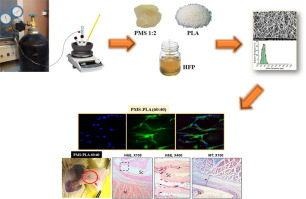Biomaterials Advances ( IF 7.9 ) Pub Date : 2020-01-11 , DOI: 10.1016/j.msec.2020.110626 Mahya Rahmani , Mohammad-Mehdi Khani , Shahram Rabbani , Alireza Mashaghi , Farsad Noorizadeh , Reza Faridi-Majidi , Hossein Ghanbari

|
Developing a biomimetic substrate with intrinsic potential for cell attachment and growth has always been a tissue engineering challenge. In the present research, we successfully fabricated PMS:PLA nanofibrous scaffolds for the first time using electrospinning process by adjusting blending ratios, feed rates and polymer concentrations. A desirable composition was found when homogenous nanofibers with an average fiber diameter of 235 ± 38 nm were achieved at 10% w/v for PMS:PLA 60:40. The scaffolds were then characterized for their microstructure, mechanical strength and elasticity, degradation rate, porosity, wettability and cell/tissue compatibility. Mechanical analysis and degradation behavior of PMS:PLA nanofibrous scaffolds revealed appropriate elasticity, stiffness and strength, as well as degradation rate appropriate for soft tissues. Nitrogen adsorption-desorption analysis discovered that mesoporous nanofibers with enhanced specific surface area were fabricated. Further in vitro and in vivo biocompatibility evaluations revealed enhanced cytocompatibility, proliferation and tissue responses of PMS:PLA nanofibrous scaffolds with desirable cell-scaffold interactions. Moreover, PMS:PLA nanofibrous scaffolds exhibited negligible inflammatory responses with significantly thinner fibrotic capsule formation and minor infiltration of inflammatory cells compared to PLA nanofibers. These findings suggest that PMS/PLA nanofibrous scaffolds could be introduced as potential candidates with improved properties for soft tissue engineering applications.
中文翻译:

聚(癸二酸甘露醇)/聚(乳酸)纳米纤维支架的开发及其在组织工程中的潜在应用
开发具有细胞附着和生长固有潜力的仿生底物一直是组织工程学的挑战。在本研究中,我们通过调节混合比,进料速率和聚合物浓度,首次成功地使用静电纺丝工艺成功制造了PMS:PLA纳米纤维支架。对于PMS:PLA 60:40,当平均纤维直径为235±38 nm的均质纳米纤维达到10%w / v时,发现了理想的组成。然后表征支架的微观结构,机械强度和弹性,降解速率,孔隙率,润湿性和细胞/组织相容性。PMS:PLA纳米纤维支架的力学分析和降解行为显示出合适的弹性,刚度和强度,以及适合软组织的降解速率。氮吸附-解吸分析发现,制备了具有增加的比表面积的中孔纳米纤维。进一步的体外和体内生物相容性评估显示,具有所需细胞-骨架相互作用的PMS:PLA纳米纤维支架具有增强的细胞相容性,增殖和组织反应。此外,与PLA纳米纤维相比,PMS:PLA纳米纤维支架表现出可忽略的炎症反应,其纤维化囊的形成明显更薄,炎症细胞的浸润较小。这些发现表明,PMS / PLA纳米纤维支架可作为具有改善的性能的潜在候选物引入软组织工程应用。进一步的体外和体内生物相容性评估显示,具有所需细胞-骨架相互作用的PMS:PLA纳米纤维支架具有增强的细胞相容性,增殖和组织反应。此外,与PLA纳米纤维相比,PMS:PLA纳米纤维支架表现出可忽略的炎症反应,其纤维化囊的形成明显更薄,炎症细胞的浸润较小。这些发现表明,PMS / PLA纳米纤维支架可作为具有改善的性能的潜在候选物引入软组织工程应用。进一步的体外和体内生物相容性评估显示,具有所需细胞-骨架相互作用的PMS:PLA纳米纤维支架具有增强的细胞相容性,增殖和组织反应。此外,与PLA纳米纤维相比,PMS:PLA纳米纤维支架表现出可忽略的炎症反应,其纤维化囊的形成明显更薄,炎症细胞的浸润较小。这些发现表明,PMS / PLA纳米纤维支架可作为具有改善的性能的潜在候选物引入软组织工程应用。与PLA纳米纤维相比,PLA纳米纤维支架的炎症反应可忽略不计,其纤维化囊的形成明显更薄,炎症细胞的浸润较小。这些发现表明,PMS / PLA纳米纤维支架可作为具有改善的性能的潜在候选物引入软组织工程应用。与PLA纳米纤维相比,PLA纳米纤维支架的炎症反应可忽略不计,其纤维化囊的形成明显更薄,炎症细胞的浸润较小。这些发现表明,PMS / PLA纳米纤维支架可作为具有改善的性能的潜在候选物引入软组织工程应用。



























 京公网安备 11010802027423号
京公网安备 11010802027423号